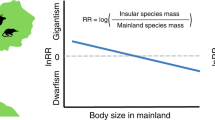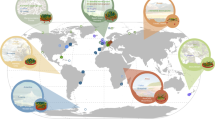Abstract
We present data and analyses demonstrating that large species utilize a disproportionately large share of the resources within local ecosystems. Even though small species tend to have higher local population densities, these are not sufficient to compensate for their lower rates of energy use per individual. The relationship is very general; holding for example for birds, mammals, fish and plants. We suggest that several ecological advantages enable larger species and larger individuals within species to monopolize resources, and that the resulting selection pressures are responsible for the evolutionary trend towards increasing body size seen in many phyletic lineages. Our results contradict important studies1–4 that have concluded that species of small body size use at least as large a proportion of the resources within ecosystems as their larger relatives.
This is a preview of subscription content, access via your institution
Access options
Subscribe to this journal
Receive 51 print issues and online access
$199.00 per year
only $3.90 per issue
Buy this article
- Purchase on Springer Link
- Instant access to full article PDF
Prices may be subject to local taxes which are calculated during checkout
Similar content being viewed by others
References
Damuth, J. Nature 290, 699–700 (1981).
Peters, R. H., The Ecological Implications of Body Size (Cambridge University Press, Cambridge, 1983).
Peters, R. H. & Wassenberg, K. Oecologia 60, 89–90 (1983).
Peters, R. H. & Raelson, J. V. Am. Nat. 124, 498–517 (1984).
Odum, E. P. Am. Zool. 8, 11–18 (1968).
Odum, H. T., Systems Ecology (Wiley, New York, 1983).
Garland, T. Am. Nat. 121, 571–587 (1983).
Mace, G. M. & Harvey, P. H. Am. Nat. 121, 120–132 (1983).
Walsberg, G. E. . in Avian Biology vol. 6, (eds Farner, D. S. & King, J. R.) 161–220 (Academic, New York, 1983).
Calder, W. A. Size, Function, and Life History (Harvard University Press, Cambridge, 1984).
Mooney, H. A. A. Rev. ecol Syst. 3, 315–346 (1972).
Schulze, E. D. in The Encyclopedia of Plant Physiology, new series vol. 126, 616–676 (Springer, Berlin, 1982).
Dunning, J. B. Western Bird Banding Assoc. Monogr. 1, 1–38 (Eldon, Cave Creek, 1984).
Kermack, K. A. & Haldane, J. B. S. Biometrika 37, 30–41 (1950).
Brown, J. H. & Munger, J. C. Ecology 66, 1545–1563 (1985).
Smith, C. L. & Taylor, J. C. . in Results of the Tektite Program: Ecology of Coral Reef Fishes vol. 14 (eds Collette, B. B. & Earl, S. A.) 125–170 (Science Bulletin, Natural History Museum of Los Angeles County, 1972).
Thomson, D.A. & Lehner, C.E. J. exp. mar. biol Ecol 22, 1–28 (1976).
Horn, M. H. & Allen, L. G. California Department of Fish and Game Tech. Rep. 45, 1–36 (1981).
Turner, R. M. & Brown, D. E. . in Desert Plants vol. 4,(ed. Brown, D. E.) 181–221 (University of Arizona, Tucson, 1982).
Kurzius, M. A. Thesis, Univ. Nevada, Las Vegas, 1981.
Morse, D. H., Behavioral Mechanism in Ecology (Harvard University Press, Cambridge, 1980).
Sibley, R. M. . in Physiological Ecology (eds Townsend, C. R. & Callow, P.) 109–139 (Blackwell, London, 1981).
Stanley, S. M. Macroevolution (Freeman, San Francisco, 1979).
Bakker, R. T. in Patterns of Evolution (ed. Hallam, A.) 431–478 (Elsevier, Amsterdam, 1977).
Fowler, C. W. & MacMahon, J. A. Am. Nat. 119, 480–498 (1982).
Author information
Authors and Affiliations
Rights and permissions
About this article
Cite this article
Brown, J., Maurer, B. Body size, ecological dominance and Cope's rule. Nature 324, 248–250 (1986). https://doi.org/10.1038/324248a0
Received:
Accepted:
Issue Date:
DOI: https://doi.org/10.1038/324248a0
This article is cited by
-
Ecological determinants of Cope’s rule and its inverse
Communications Biology (2024)
-
The Picocoraciades (hoopoes, rollers, woodpeckers, and allies) from the early Eocene London Clay of Walton-on-the-Naze
PalZ (2024)
-
Is a downwards head tilt a cross-cultural signal of dominance? Evidence for a universal visual illusion
Scientific Reports (2022)
-
Density-dependence and environmental variability have stage-specific influences on European grayling growth
Oecologia (2022)
-
Mammalian body size is determined by interactions between climate, urbanization, and ecological traits
Communications Biology (2021)
Comments
By submitting a comment you agree to abide by our Terms and Community Guidelines. If you find something abusive or that does not comply with our terms or guidelines please flag it as inappropriate.



